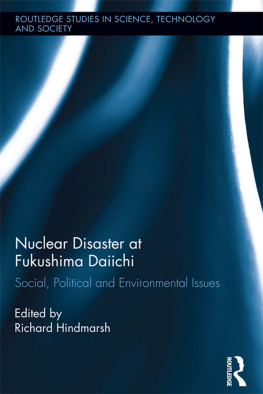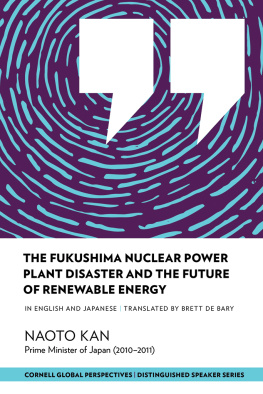Andrew Leatherbarrow - Melting Sun: The History of Nuclear Power in Japan, and the Disaster at Fukushima Daiichi
Here you can read online Andrew Leatherbarrow - Melting Sun: The History of Nuclear Power in Japan, and the Disaster at Fukushima Daiichi full text of the book (entire story) in english for free. Download pdf and epub, get meaning, cover and reviews about this ebook. year: 2022, genre: Politics. Description of the work, (preface) as well as reviews are available. Best literature library LitArk.com created for fans of good reading and offers a wide selection of genres:
Romance novel
Science fiction
Adventure
Detective
Science
History
Home and family
Prose
Art
Politics
Computer
Non-fiction
Religion
Business
Children
Humor
Choose a favorite category and find really read worthwhile books. Enjoy immersion in the world of imagination, feel the emotions of the characters or learn something new for yourself, make an fascinating discovery.

- Book:Melting Sun: The History of Nuclear Power in Japan, and the Disaster at Fukushima Daiichi
- Author:
- Genre:
- Year:2022
- Rating:5 / 5
- Favourites:Add to favourites
- Your mark:
- 100
- 1
- 2
- 3
- 4
- 5
Melting Sun: The History of Nuclear Power in Japan, and the Disaster at Fukushima Daiichi: summary, description and annotation
We offer to read an annotation, description, summary or preface (depends on what the author of the book "Melting Sun: The History of Nuclear Power in Japan, and the Disaster at Fukushima Daiichi" wrote himself). If you haven't found the necessary information about the book — write in the comments, we will try to find it.
Melting Sun: The History of Nuclear Power in Japan, and the Disaster at Fukushima Daiichi — read online for free the complete book (whole text) full work
Below is the text of the book, divided by pages. System saving the place of the last page read, allows you to conveniently read the book "Melting Sun: The History of Nuclear Power in Japan, and the Disaster at Fukushima Daiichi" online for free, without having to search again every time where you left off. Put a bookmark, and you can go to the page where you finished reading at any time.
Font size:
Interval:
Bookmark:
MELTING SUN
THE HISTORY OF NUCLEAR POWER IN JAPAN
AND THE DISASTER AT FUKUSHIMA DAIICHI
Andrew Leatherbarrow
For Nicole, Jo and Noah, whom I neglected far too
much during the years I spent working on this book.
What will happen if an earthquake greater than magnitude 8.5 hits a Japanese nuclear plant?
Then it will be the same as Chernobyl. But that kind of case will never happen.
Yuji Kurotani, senior examiner,
Nuclear Power Safety Examination Division (Agency for Natural Resources and Energy), 1999
What must be admitted very painfully is that this was a disaster Made in Japan. Its fundamental causes are to be found in the ingrained conventions of Japanese culture: our reflexive obedience; our reluctance to question authority; our devotion to sticking with the programme; our groupism; and our insularity. Had other Japanese been in the shoes of those who bear responsibility for this accident, the result may well have been the same.
Kiyoshi Kurokawa, chairman
National Diet of Japan Fukushima Nuclear Accident Independent Investigation Commission
Companies and Organisations
AEC Atomic Energy Commission (United States)
AEG Allgemeine Elektrizitts Gesellschaft (Germany)
AFC Atomic Fuel Corporation
ANRE Agency for Natural Resources and Energy
BNFL British Nuclear Fuels Limited (United Kingdom)
CRIEPI Central Research Institute of the Electric Power Industry
DPJ Democratic Party of Japan (left-wing)
EPDC Electric Power Development Company
FEPC Federation of Electric Power Companies
GEC General Electric Company (United Kingdom)
GE General Electric (United States)
IAEA International Atomic Energy Agency
INSS Institute of Nuclear Safety System [sic]
JAEC Japan Atomic Energy Commission
JAERI Japan Atomic Energy Research Institute
JAPC Japan Atomic Power Company
JCO Japan Nuclear Fuel Conversion Company
JCP Japan Communist Party
JMA Japan Meteorological Agency
JNC Japan Nuclear Cycle Development Institute
JNFL Japan Nuclear Fuel Limited
JNSDA Japan Nuclear Ship Development Agency
JSCCS Japan Society for Corporate Communication Studies
JSDF Japan Self-Defense Forces
KEPCO Kansai Electric Power Company
LDP Liberal Democratic Party (right-wing)
METI Ministry of Economy, Trade and Industry (2001present)
MEXT Ministry of Education, Culture, Sports, Science and Technology (2001present)
NAIIC National Diet of Japan Fukushima Nuclear Accident Independent Investigation Commission
MHLW Ministry of Health, Labour and Welfare
MITI Ministry of International Trade and Industry (19492001)
NIRS National Institute of Radiological Sciences
NISA Nuclear and Industrial Safety Agency
NRA Nuclear Regulation Authority
NRC Nuclear Regulatory Commission (United States)
NSC Nuclear Safety Commission
OELCO Osaka Electric Light Company
OPEC Organization of Petroleum Exporting Countries
PNC Power Reactor and Nuclear Fuel Development Corporation
RBMK High-power Channel-type Reactor (Russian: Reaktor Bolshoy Moshchnosti Kanalnyy)
SCAP Supreme Commander for the Allied Powers
STA Science and Technology Agency (19562001)
TEPCO Tokyo Electric Power Company
USIS United States Information Service
UTH University of Tokyo Hospital
Technologies and Terminologies
ABWR Advanced Boiling Water Reactor
AGR Advanced Gas-Cooled Reactor
ARS Acute Radiation Syndrome
ASTRID Advanced Sodium Technological Reactor for Industrial Demonstration
ATR Advanced Thermal Reactor
AVB Anti-Vibration Bar
BWR Boiling Water Reactor
DDFP Diesel-Driven Fire Pump
ECCS Emergency Core Cooling System (encompasses multiple safety systems)
ERC Emergency Response Centre
FAC Flow-Accelerated Corrosion
FBR Fast Breeder Reactor
HPCI High-Pressure Coolant Injection
HWR Heavy Water Reactor
IC Isolation Condenser
IVTM In-Vessel Transfer Machine
JPDR Japan Power Demonstration Reactor
JRR-1 Japan Research Reactor 1
LNG Liquid Natural Gas
LOCA Loss-of-Coolant Accident
LWR Light Water Reactor, encompassing BWRs, PWRs and others
MOX Mixed-Oxide Fuel
MSIV Main Steam Isolation Valve
OFC Off-Site Centre
PORV Pilot-Operated Relief Valve
PWR Pressurised Water Reactor
RCIC Reactor Core Isolation Cooling
RETF Recycle Equipment Test Facility
RHR Residual Heat Removal System
SIB Seismic-Isolation Building
SPEEDI System for Prediction of Environmental Emergency Dose Information
SRV Safety Relief Valve
MAPS & DIAGRAMS



On the afternoon of 11th March 2011, an earthquake shook the Pacific Ocean floor with a force so violent it redistributed Earths mass, altering its figure axis and shortening our day/night cycle by 1.8 microseconds. From the epicentre, 75 kilometres east of Japan, rose a towering, unstoppable wall of water. This tsunami breached Japans coastline within 40 minutes, crashing against the Onagawa Nuclear Power Station the closest nuclear facility to ground zero with waves as high as 14 metres (46 feet). Tremors rocked the hardened facility far beyond its maximum tolerances, but Onagawa survived the dual onslaught relatively unscathed and even became a refuge shelter for those made homeless in the chaos. Just over half an hour later, the tsunami reached a second power station: Fukushima Daiichi. The Tokyo Electric Power Company (TEPCO), Daiichis owner and one of the worlds largest and most influential utilities, claimed they took every conceivable measure to prepare for such an event. It wasnt enough a deluge of water overwhelmed Fukushimas inadequate coastal defences with ease, crippling the sites ability to cool its six reactors, plunging the government into a catatonic crisis and instigating the worst nuclear disaster in 25 years.
2011s Great East-Japan Earthquake may have been a natural trigger, but Fukushima Daiichis downfall was very much a preventable, man-made event: one Japan should have been well prepared for. Minor earthquakes hit the country every single day, after all, and major ones with accompanying tsunami come every few years. Indeed, the Japanese rank among the least likely people to espouse atomic energy and were its most passionate detractors until a post-World War II, CIA-backed propaganda campaign turned public perception around. From the very beginning, however, the Japanese energy industry failed to afford due consideration to the serious threat posed by tsunami while being plagued by negative foreign influence, safety violations, technological setbacks and cultural peculiarities that stifled genuine independent oversight.
Accidents are inevitable in any industry, but rather than form substantial accident-mitigating countermeasures, power utilities and the government focused on accident prevention almost exclusively. It didnt work, leading Kyushu and Thoku University researchers to conclude in 2018 that Japan has had more nuclear accidents of greater severity than [all] other countries. Insiders proclaimed their technology infallible and, when significant accidents did occur, they were often concealed or explained away with a convenient scapegoat. Meanwhile, a powerful clique of politicians, business leaders, media figures and academics prevented any widespread critical discourse. Along the way, what began as an ambitious and cutting-edge dream fell apart as technological difficulties, inadequate regulation, a box-ticking approach to safety inspections, cover-ups and mounting public opposition hampered the industrys ability to fulfil its goals.
Next pageFont size:
Interval:
Bookmark:
Similar books «Melting Sun: The History of Nuclear Power in Japan, and the Disaster at Fukushima Daiichi»
Look at similar books to Melting Sun: The History of Nuclear Power in Japan, and the Disaster at Fukushima Daiichi. We have selected literature similar in name and meaning in the hope of providing readers with more options to find new, interesting, not yet read works.
Discussion, reviews of the book Melting Sun: The History of Nuclear Power in Japan, and the Disaster at Fukushima Daiichi and just readers' own opinions. Leave your comments, write what you think about the work, its meaning or the main characters. Specify what exactly you liked and what you didn't like, and why you think so.







